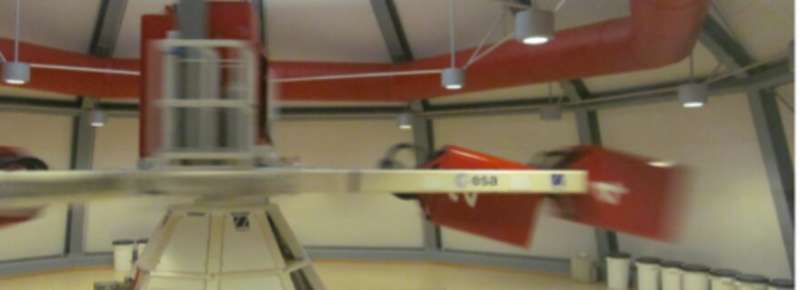Making cells ultra-heavy

The life of a fibroblast is heavy, but PhD student Julia Eckert makes it 19.5 times heavier, using the Large Diameter Centrifuge at the ESTEC space research centre in Noordwijk.
"Cells experience mechanical forces of their surroundings and sense the mechanical properties of the substrate on which they are connected," says Ph.D. student Julia Eckert. Recently, it has become clear that these mechanical forces influence the biomolecular functioning of the cell. But how exactly, is far from understood.
This is why Eckert exposed mouse fibroblast cells to unnaturally high artificial gravity of 19.5 g, during a collaborative project between Leiden University, TU Dresden and the European Space Agency ESA. The paper has appeared on the preprint server bioRxiv.org, and is under review with Biophysical Journal.
Fibroblasts are cells responsible for producing collagen and other elements of the extracellular matrix, the structure that embeds living cells. Eckert was interested in the pulling forces that those cells can exert. She measured them using tiny floppy micropillars, developed in Thomas Schmidt's research group.
Nano-newtons
With the cells placed on top of those pillars, the lateral forces become visible from the bending of the pillars. "Using a confocal microscope, we can measure the forces of live fibroblasts down to a few nano-newtons," says Eckert.
Of course, one of the forces that constantly acts on cells is gravity, which cannot easily be switched off in order to separate its influence. One method to do so would be an experiment at ultra-low gravity aboard the International Space Station (ISS), an experiment which is planned in the future. A cheaper approach to change gravity is to increase it. One can do this using the Large Diameter Centrifuge available at ESA's ESTEC research centre in Noordwijk.
"The experiment, including the incubator to keep cells at a correct temperature, was mounted in one of the gondolas, which is connected to a 4-meter long arm that rotates about an axis," Eckert explains. Gondolas could be mounted at different distances to adjust gravity levels. "We had the experiments running overnight and at different gravitational levels," explains Eckert.
Die Astronautin
The measurements showed that the forces which cells applied on the micropillars decreased by 5 nano-newtons at 5.4 g, while they increased for higher g-levels up to 19.5 g, the maximum that can be achieved in the centrifuge. This seems to indicate that the lateral cellular skeleton responded to the extreme gravity, by first weakening, and subsequent reorganisation and strenghthening of the cytoskeleton. Eckert: "The next step would be to check whether cells in clusters react similarly."
However, Eckert left ESTEC and this area of research after her Master's degree in Physics. "It was a very special experience to work with ESA researchers. University research is international and fast changing, but this was all the more true for ESA research."
Eckert's fascination for spaceflight and space has been with her from when she was a young girl. When the 'Die Astronautin' was launched, a German private initiative looking for the first female astronaut, she applied. "I didn't expect to get far, but I just wanted to be able to say I tried." Eckert made it to the second round.
More information: J. Eckert et al. Hypergravity affects Cell Traction Forces of Fibroblasts, (2020). DOI: 10.1101/2020.03.30.015958
Journal information: Biophysical Journal
Provided by Leiden University




















